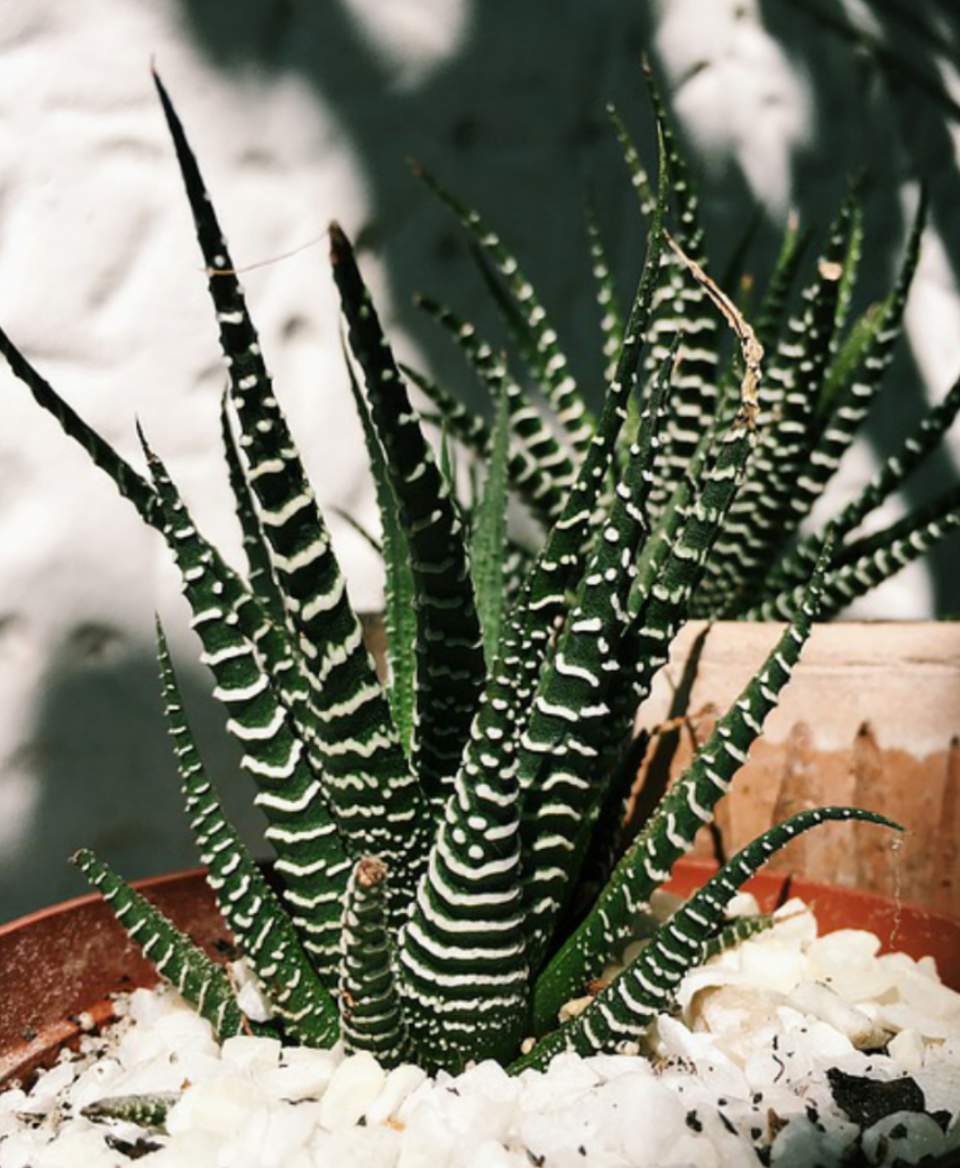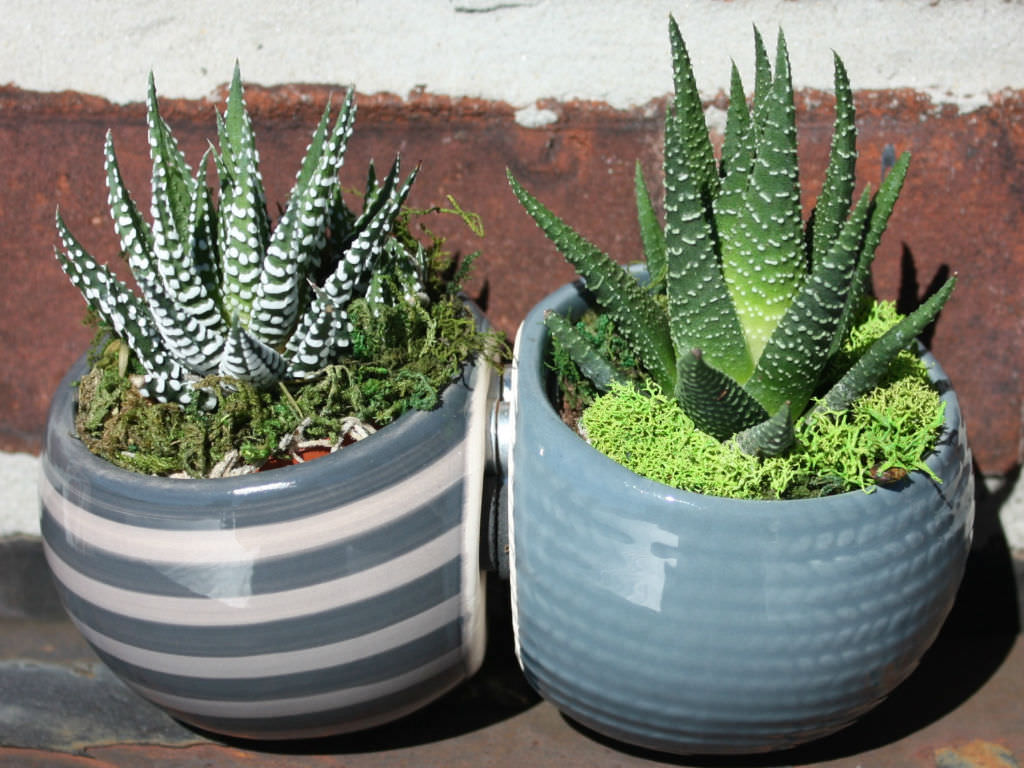When the potting dirt around zebra succulents has sufficiently dried out, water them. The zebra plant’s typical watering needs are met by giving it a good soak once every two to three weeks to prevent root rot. Before watering your zebra succulent, make sure the soil is dry.

Knowing how frequently to water zebra succulents, also known as zebra Haworthia and Haworthiopsis fasciata, is crucial because they are prone to root rot brought on by excessive watering and poorly draining soils.
Zebra succulents can go into a state of hibernation in the summer as a response to high temperatures and as a method to cope with dryness, thus they have varied watering needs at different times of the year.
To avoid water stress and maintain the health of your zebra plant, the ideal watering schedule should be used in conjunction with coarse, well-draining, succulent soil and the appropriate pot.
For additional information on how to determine your climate’s conditions and the best times of year to water your zebra succulent, keep reading.
Table of Contents
How Often to Water Zebra Succulents
Zebra succulents are specially adapted to thrive in hot, arid environments with infrequent rainfall and rocky soil. For example, they store moisture in their thick leaves, which are likewise designed to minimize water loss through transpiration.
Zebra succulents prefer dryer conditions than most plants since they are so well suited to thriving in drought, and they are more prone to experience issues from overwatering than from underwatering, such as foliage turning brown or yellow and root rot.
It’s crucial to mimic the watering conditions of their natural environment if you want to take good care of zebra succulents in your home.
Only water your zebra succulent when the earth is absolutely dry since zebra succulents need the soil to dry out between sessions of watering. To attain the ideal balance of moisture, zebra succulents often need to be watered once every two to three weeks with a good soak.
Potting soil does not always dry out at the same rate for a variety of reasons, including:
- climate’s humidity and temperature range.
- How big the pot is (large pots dry out much slower then smaller pots).
- Whether the zebra succulent is near a heat source or in an air stream.
- the potting soil’s capacity to hold moisture.
Feel the soil at the bottom of the pot via the drainage hole to determine how frequently to water zebra succulents according to the climate and conditions where you live. Delay watering for a few days if the soil feels damp. This is the ideal time to water if the soil seems dry.
When you know how long it typically takes for the soil surrounding your zebra succulent to dry out, you can create a watering schedule that suits your needs and faithfully imitates the moisture and watering conditions in their natural habitat.
Symptoms of Watering Zebra Plants Too Often
Zebra succulents shouldn’t need to be watered more regularly than once a week, so stop.
Zebra succulents exhibit signs of stress when their leaves turn yellow or brown and have a mushy, soft texture. If the leaves become black, this may be a sign of root rot brought on by excessive watering.
Reduce your watering and allow the potting soil to totally dry out around the roots of the zebra succulent if its leaves start to turn brown or yellow and have a soft texture so that it can recover.
(Read my article on how to save a dying zebra succulent for additional details.)
Symptoms of Under Watering Zebra Succulents
Despite being drought-tolerant, zebra plants can still experience drought stress if they are ignored or given little water.
Brown leaf tips and potentially brown, crispy, dry-looking leaves at the base of the plant are signs of an under-watered zebra succulent.
As the zebra succulent uses up its moisture reserves, the thick leaves that hold moisture also appear thinner.
Give the dirt a good soak, and you might want to water your zebra plant more frequently (as long as the soil dries out between bouts of watering).
Keep zebra succulents away from air currents or draughts brought on by forced air systems or air conditioning, since too much airflow might dry out the tapered leaf tips.
(To understand more, see my article about zebra succulents with brown leaf tips.)
The zebra succulent should recover in the next weeks with two or three cycles of watering with a generous soak.
It’s also important to keep in mind that zebra plants may need more or less watering depending on the season.
How Often to Water Zebra Succulents in Winter
Depending on the season, zebra succulents’ needs for water can change.
Zebra succulents demand less irrigation in the winter than they do in the spring or fall (which are the more active growing seasons).
This is due to the fact that the pace of soil evaporation is frequently slower in the winter, and the plant can develop more slowly with less intense light and shorter daytime hours, which lowers its need for water.
However, as zebra plants are typically cultivated inside, they might be placed close to a source of heat in the winter, which might cause the soil to dry up much more quickly.
In the winter, try to keep your zebra succulent away from any sources of heat and, ideally, place it in bright indirect light.
Watering once every three weeks in the winter is usually enough, but since this varies, I advise monitoring how quickly your potting soil dries out and adjusting the frequency of watering so that the soil around the roots can dry out to prevent root rot while also providing enough moisture to prevent drought stress.
How Often to Water Zebra Succulents in Summer
Zebra plants thrive in chilly spring and fall months and prefer direct, strong light.
Zebra plants can grow throughout the summer, but when the temperatures are extremely high, they tend to go into dormancy to limit their need for water to live, which makes them more vulnerable to overwatering.
Water your zebra plant once every three to four weeks when the daily high is consistently over 80 °F (27 °C), and position it in brilliant indirect sunshine rather than any direct sunlight.
Be watchful during the hot Summers and keep an eye out for symptoms of overwatering (brown or yellow leaves that feel soft) and signs of drought stress (such as brown leaf tips and brown, dry bottom leaves) so you can change your watering schedule accordingly.
This summer dormancy, which slows active development and lowers need for water until there are more bearable temperatures, is a survival tactic to deal with hot temperatures and dry conditions.
How Much to Water Zebra Succulents
To keep your zebra plant healthy, you must know how much water to provide it.
Zebra succulents should receive the same amount of water, regardless of the climate, humidity, or temperature.
Give zebra succulents a generous soak of water, letting any extra water flow out the bottom of the pot.
To ensure that the water has adequately soaked into the soil and reached the zebra plant’s roots, water until a trickle emerges from the pot.
Giving your plants plenty of water also promotes healthy root growth.
Only the top inch or two of the soil becomes moist when you water too lightly, and the water does not go to the roots where it is needed. A typical reason for drought stress and withered leaves is underwatering.
(It should be noted that both overwatering and underwatering can cause succulent leaves to shrink; to learn how to discern the difference, read my article.)
The zebra plant is kept healthy by simulating the watering conditions in its natural habitat by giving it a deep soak and then letting the soil dry out.
Well Draining Soil to Avoid Over Watering
Normal potting soil causes the drought-adapted zebra plant’s leaves to turn brown or yellow and mushy because it holds too much moisture around the plant’s roots.
In their native South Africa, zebra succulents naturally thrive in sandy or rocky soils with quick drainage and a lack of moisture retention.
Plant zebra succulents in special succulent and cactus potting soil (available from garden centers and amazon) to maintain the health of the plant and prevent root rot. This soil closely resembles the unique, well-draining soil profile of the succulent’s native location.
It is much simpler to maintain the ideal moisture balance for zebra succulents with the correct soil and avoid any effects from overwatering to keep the plant healthy.
When you have the correct soil, it is much simpler to keep your zebra plant healthy and to maintain the ideal moisture balance for jade plants. You can also avoid the negative effects of overwatering.
(Read my article on how to cultivate and take care of zebra succulents for additional information.)
Use a Pot With Drainage Holes in The Base

The easiest approach to make sure your zebra succulent has received enough water is to water until extra water trickles out of the pot’s base.
When zebra succulents are planted in pots without drainage holes on the bottom, water pools around the roots, which can result in brown or yellow leaves or root rot.
In your plant’s pot, water may still collect around the roots if:
- Roots or compacted earth have blocked the drainage opening. If you notice that your soil is draining slowly, make sure the drainage holes are clear so that water may properly escape.
- Pots are supported by trays and saucers. To prevent water from overflowing in your home, it is fairly normal to place saucers or trays underneath the zebra succulent container. To keep the soil from remaining too wet for your zebra succulent, constantly empty the saucer or tray to prevent water from gathering.
- the application of ornamental outer pots. Sometimes, zebra succulents are offered in plastic pots with drainage holes, but these pots are covered with attractive outer pots to make them seem nice and keep water from pouring inside your house. The outer pot, however, prevents water from leaving, causing the soil to be damp and leading to root rot. As a result, either routinely empty the water from the pot, or plant in a pot with drainage holes in the base.
Key Takeaways:
- Zebra succulents can withstand drought and should only be watered after the ground has totally dried out. Watering the zebra plant once every two to three weeks typically suffices while preventing root rot from excessive watering.
- Plant zebra succulents in stony, permeable succulent and cactus soil to mimic the drainage qualities of their natural habitat.
- To prevent root rot, zebra succulents should be planted in containers with drainage holes on the bottom.
- The signs of an overwatered zebra succulent are mushy, brown or yellow leaves. Brown leaf tips and crispy brown leaves at the base of the plant are signs of a dry zebra succulent. Zebra succulents should have thick, dark-green foliage. Zebra succulents should only be watered when the soil has dried between applications.
